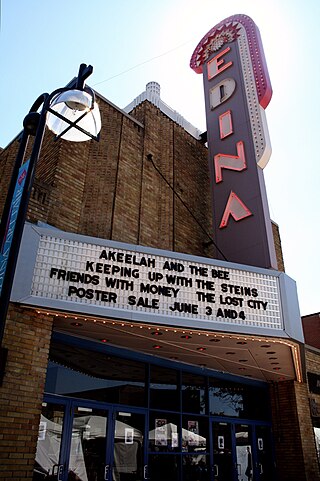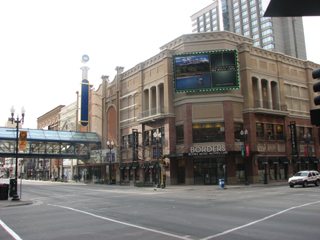
The McNamara Alumni Center at the University of Minnesota's Twin Cities campus in Minneapolis, Minnesota. Designed by Antoine Predock, it is one of the more architecturally striking buildings in the Twin Cities. The building, opened in 2000, contains two main components: University office space and 10 meeting rooms for University and public use. The University owns the land, but the University of Minnesota Gateway Corporation, consisting of the U of M Foundation and U of M Alumni Association, owns the structure.

Al's Breakfast is reportedly the narrowest restaurant in the city of Minneapolis, at a width of ten feet (3.0 m). Al's Breakfast is crammed into a former alleyway between two much larger buildings and is located in the city's Dinkytown neighborhood near the University of Minnesota. The restaurant's 14 stools have seated generations of local students, along with notable figures such as writer James Lileks and humorist Garrison Keillor, all of whom consider the tiny diner to be a significant icon of the state.

Saint Anthony Main is an stretch of buildings on Main Street across from Saint Anthony Falls in the Marcy-Holmes and Nicollet Island/East Bank neighborhoods of Minneapolis. The area is part of Southeast, Minneapolis, as it was originally the Main Street through the township of St. Anthony, Minnesota prior to most of that township's annexation in 1872. It opened as a festival marketplace in the 1980s.

The Pantages Theatre is a historic theatre in Minneapolis, Minnesota. The original building was a Beaux-Arts style twelve-story complex on Hennepin Avenue, designed by Kees & Colburn and operated by Alexander Pantages, a Greek immigrant who opened 500 theatres.

50th & France is a commercial district located in the area of West 50th Street and France Avenue South in the cities of Edina and Minneapolis in the U.S. state of Minnesota. It includes over 175 retail shops and offices. Shops include various apparel stores, craft stores, jewelers, restaurants, cafes, spas, salons, and multiplex art-house movie theater. The district is known for more upscale businesses and services. In 2007, a mid-rise condominium building, with units going for well over $1 million, was built on the southwest corner of the intersection.
Midtown is a loosely defined region in south Minneapolis, Minnesota, United States. There are no hard-set boundaries to the midtown area, but it is generally agreed to include the area in the vicinity of Lake Street between Interstate 35W and Hiawatha Avenue. Lake Street is the border between the Phillips and Powderhorn communities of Minneapolis. Lake Street/Midtown LRT Station, with service on the METRO Blue Line, is located on the eastern edge of the area.

Mayo Clinic Square on Block E in downtown Minneapolis, is a building bounded by Hennepin Avenue, North 6th Street, North 7th Street, and 1st Avenue North. It is part of the Downtown West neighborhood in Minneapolis, historically known as the Warehouse District. It is one block south of the Warehouse District/Hennepin Avenue light rail station on the METRO Blue and Green lines. "Block E" is a City planning department designation of the block; other blocks have similar designations
Minneapolis is the largest city in the US state of Minnesota, and the county seat of Hennepin County.
Minnesota Center for Book Arts (MCBA) is the largest and most comprehensive independent nonprofit book arts center in the United States. Located in Minneapolis, Minnesota, MCBA is a nationally recognized leader in the celebration and preservation of traditional crafts, including hand papermaking, letterpress printing and hand bookbinding, as well as the use of these traditional techniques by contemporary artists in creating new artists' books and artwork.

Timber Lodge Steakhouse is a privately owned American steakhouse chain with one location in Minnesota. Formerly a public company, it had eighty-five locations at its peak.

The Southern Theater is located in the Cedar-Riverside neighborhood of Minneapolis, Minnesota. Built in 1910 as a cultural center and legitimate theater for the burgeoning Scandinavian community centered on Cedar Avenue, the Southern has been re-established as a center for contemporary performing arts over the past quarter-century. The Southern Theater is the home of Balls Cabaret, a weekly midnight cabaret entering its twenty-fourth year.

S&W Cafeteria was a Charlotte, North Carolina-based chain of cafeteria-style restaurants. The chain specialized in low-cost, Southern-style food. Branches were located in the Southeastern United States from Washington, D.C. to Atlanta, Georgia.
The Old Log Theatre was the oldest professional theater in the state of Minnesota. It was sometimes cited as the oldest continuously operating professional theater in the United States. It was located in Excelsior and was funded entirely by ticket sales and income from its restaurant.

The Minnesota Museum of American Art is an American art museum located in the Historic Pioneer Endicott building in Saint Paul, Minnesota. The museum holds more than 5,000 artworks that showcase the unique voice of American artists from the 19th century to the present. Guided by the belief that art should reflect the constantly shifting landscape that defines the American experience, the museum desires to celebrate the work of artists from the 19th and 20th centuries as well as new voices that have emerged from communities of color, immigrants, their children and grandchildren.

The Hollywood Theater is a historic theater building in Minneapolis which is listed on the U.S. National Register of Historic Places. It is located in the Audubon Park neighborhood of Minneapolis.
Nankin Cafe was a Chinese restaurant in Minneapolis, Minnesota, United States. It was considered "a downtown Minneapolis landmark for 80 years". Founded by Walter James in 1919 at 15 S. 7th Street, now the site of the Dayton-Radisson parking ramp, it was sold in 1949 to the Golden and Chalfen families. The restaurant moved across 7th Street to 20 S. 7th Street in 1958. In 1980 it was razed, along with the entire block (1979-1980), to make way for the City Center shopping center, after its owners agreed to a settlement allowing it to relocate in the new center, which it did in 1981 upon completion of the complex. The Nankin was owned by the Wu family for the last 10 years of its existence. It has been recognized for its chow mein and egg foo yung dishes that were offered as a subgum variation.
Liebenberg and Kaplan (L&K) was a Minneapolis architectural firm founded in 1923 by Jacob J. Liebenberg and Seeman I. Kaplan. Over a fifty-year period, L&K became one of the Twin Cities' most successful architectural firms, best known for designing/redesigning movie theaters. The firm also designed hospitals, places of worship, commercial and institutional buildings, country clubs, prestigious homes, radio and television stations, hotels, and apartment buildings. After designing Temple Israel and the Granada Theater in Minneapolis, the firm began specializing in acoustics and theater design and went on to plan the construction and/or renovation of more than 200 movie houses throughout Minnesota, North and South Dakota, Iowa, and Wisconsin. Architectural records, original drawings, and plans for some 2,500 Liebenberg and Kaplan projects are available for public use at the Northwest Architectural Archives.

Minneapolis City Center is a mixed-use shopping mall on Nicollet Mall in Minneapolis, Minnesota. It opened in 1983 and occupies the bottom three floors of the 33 South Sixth office building. Designed by Skidmore, Owings & Merrill, Minneapolis City Center contains 250,000 square feet (23,000 m2) of leasable retail space. The mall was built around the pre-existing Forum Cafeteria restaurant. The building is adjacent to the Marriott Hotel City Center and connected to the Gaviidae Common shopping mall.

7th-8th Street & Nicollet is a bus rapid transit station on the Metro C Line and D Line in downtown Minneapolis, Minnesota. The station is located at the intersection of Nicollet Mall, with the northbound platform located on 7th Street and the southbound platform on 8th Street. The platforms are referred to as 7th Street & Nicollet and 8th Street & Nicollet, respectively. The station is located within the Downtown Minneapolis Fare Zone, where riders can travel in the zone for 50¢ with no transfers.














